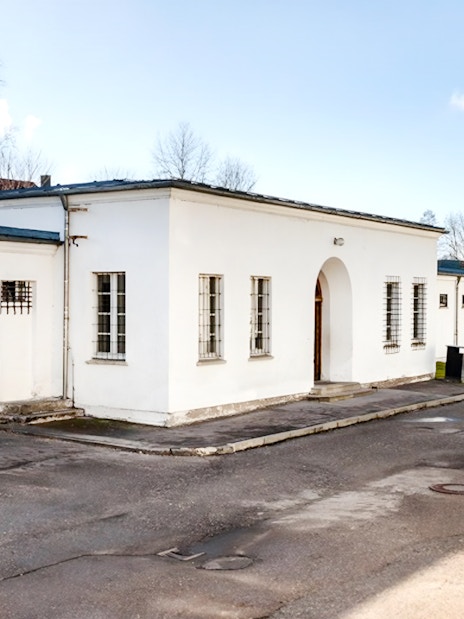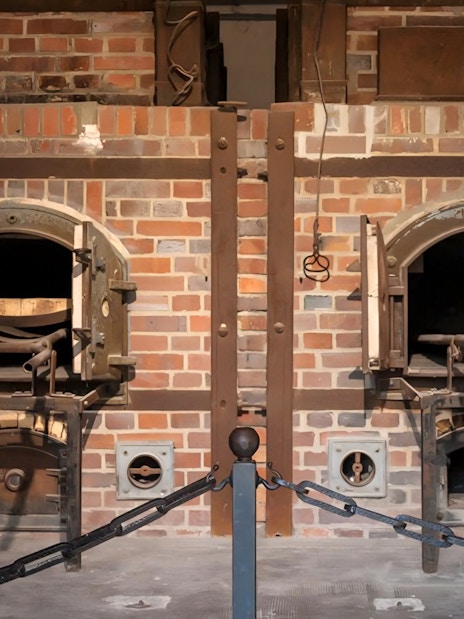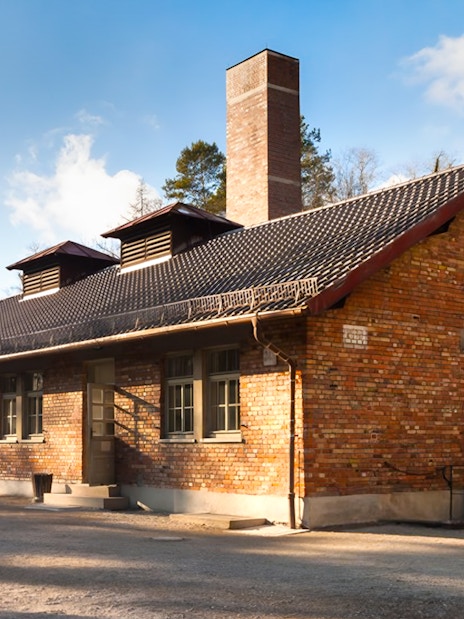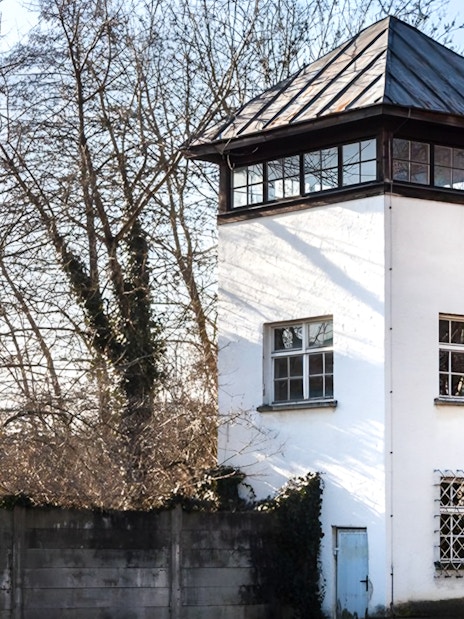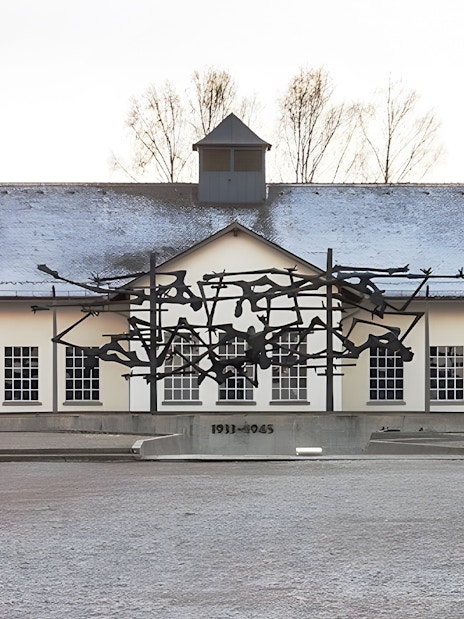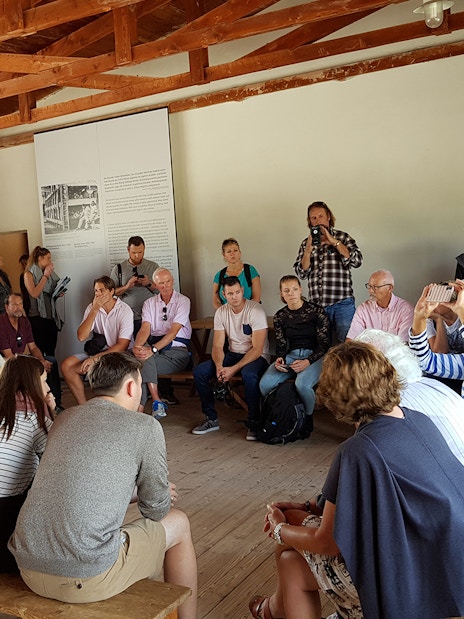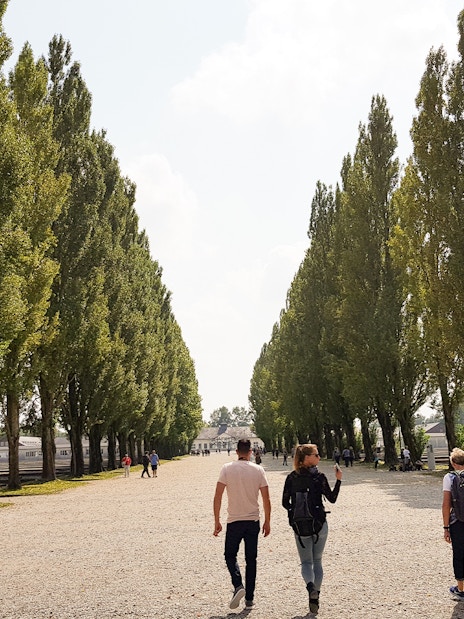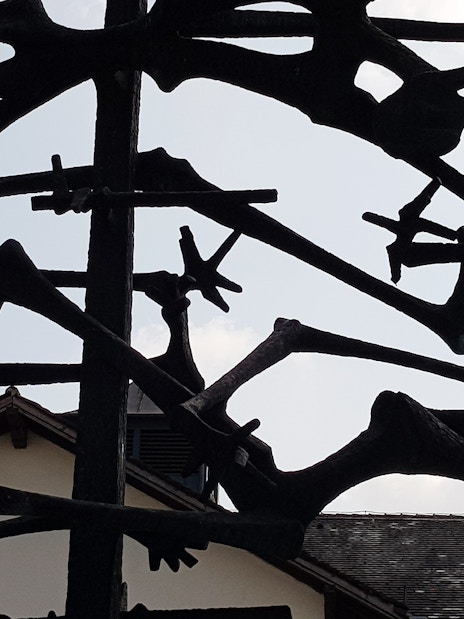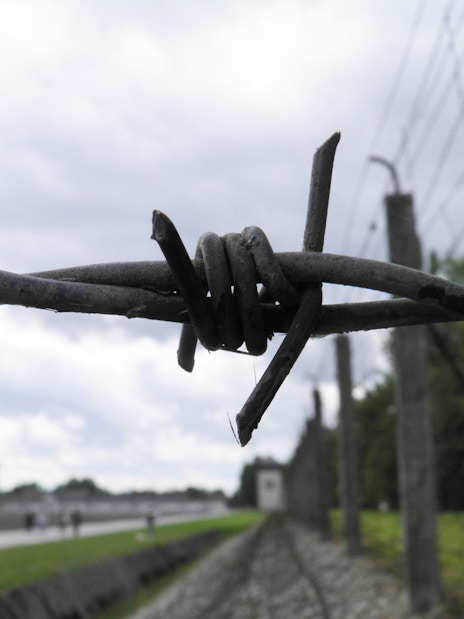Dachau Concentration Camp Tours

- Explore the Dachau concentration camps over 5 hours with an English-speaking Dachau Memorial guide and learn about this historically significant area of the 20th century.
- See the Schutzstaffel (SS) training quarters, the camp street, the crematoriums, the barracks, and the heinous gas chamber.
- Learn from your guide about the development and expansion of one of the most horrifying locations of the mid-20th century.
- Get to see the Nandor Glid Monument, a bronze sculpture made of barbed wire and skeletal shapes that portray the brutality of the confinement.
- With round-trip transfers by train and bus between Munich and Dachau, enjoy a hassle-free and relaxed experience.
- Explore the Dachau concentration camps over 5 hours with an English-speaking Dachau Memorial guide and learn about this historically significant area of the 20th century.
- See the Schutzstaffel (SS) training quarters, the camp street, the crematoriums, the barracks, and the heinous gas chamber.
- Learn from your guide about the development and expansion of one of the most horrifying locations of the mid-20th century.
- Get to see the Nandor Glid Monument, a bronze sculpture made of barbed wire and skeletal shapes that portray the brutality of the confinement.
- With round-trip transfers by train and bus between Munich and Dachau, enjoy a hassle-free and relaxed experience.
Inclusions
- 5-hour half-day tour of Dachau Concentration Camp
- English-speaking guide
- Visit the original former gas chambers
- Visit the crematorium, and prisoner barracks
- See the Nandor Glid Monument
- Round-trip transfers from Munich by train/bus
- Tip: Don't forget to check out the museum’s powerful 22-minute documentary film, which shows an account of the ascent of the Nazi Party.
- Keep in mind food is not allowed on this experience. Pack wisely!
- Safety is a priority so this experience is restricted for guests under the age of 14 years.
- Due to venue restrictions, pets cannot tag along for this experience.
- Photography is permitted but no audio, video, or written recordings are allowed.
- You can cancel these tickets up to 24 hours before the experience begins and get a full refund.
Reviews
How do we collect reviews?
Snapshots from our guests
4.8
29 ratings
24
5
0
0
0
What our guests say
Rupa
Jun 2025Verified booking
It was well explained Our guide Sam was good Arrangements were good for travel
Heather
Jun 2025Verified booking
Ticketing experience was easy; guide was great! He truly has a gift for teaching and presenting.
Terry
May 2025Verified booking
Great guide (Sam). He gave us good insight and history of the concentration camp.
Ruby
Jan 2025Verified booking
The tour was very impactful and we learnt a lot. Our guide, Marcin, was very knowledgeable, kind and open to answering questions and sharing his experiences.
Gabriel
Jan 2025Verified booking
Gustavo
Nov 2024Verified booking
Bert
Oct 2024Verified booking
Marc
Oct 2024Verified booking
Zhanat
Sep 2024Verified booking
Sebastián
Sep 2024Verified booking
Leah
Jul 2024Verified booking
The process with Headput was very convenient and well organized. I really enjoyed my tour guide Max, who was highly informed and willing to answer any question. A tour with great tour guides is all I can ask for!
Thierry
Aug 2024Verified booking
The guide Sam was very interesting, and the visit to the camp very moving...
View original review in French
Simone
Jul 2024Verified booking
Very good guide. She tells a lot of details that make you feel like you were there. Intense experience.
Maria
Jul 2024Verified booking
Ross
May 2024Verified booking
Loved the guide, who was able to bring different persspectives to the tour. He was honest about what occured and its impact, and very respectful of the environment.
Dennis
May 2024Verified booking
Good guide; a lot of knowledge and giving opportunity to think about what you see. He selected good points to look at and discuss them.
Elizabeth
May 2024Verified booking
Our Guide, Sam is very knowledge and shared all his knowledge with our group of 22 people. We met some nice people in our group. The Dachau Concentration Camp Tour was extensive. We were allowed free time to look around different areas of the camp, read stories and Sam shared photos with us. He told us of the story when he met a past prisoner. Although very sad and heart wrenching everyone needs to see and learn.
Sherry
Oct 2023Verified booking
It was easy as all we had to do was to meet the guide and he led us through the very thorough tour. Hein was so well versed and gave enough information but didn't overdo it. We wouldn't have been able to get this much out of it on our own.
Donald
Jun 2023Verified booking
The information from our guide gave me a new perspective of what actually happened in Germany that was actually completely legal for the laws at the time.
ROBERTO
Apr 2024Verified booking
Keith was awesome. Highly recommend him. Very helpfull. Regards, Carol & Roberto
Sanita
Jul 2023Verified booking
The guide was excellent. Very knowledgeable, and sincere, talking about a very painful part of history
Bryan
Jul 2023Verified booking
The guide was able to tell very meaningful stories which are obviously difficult to tell.
Andreas
May 2024Verified booking
Meng
May 2024Verified booking
Erick
Apr 2024Verified booking
- On a guided tour of the Dachau Concentration Camp available and learn about the tragic losses during the Nazi rule in Germany.
- Accompanied by an expert guide, listen to commentary about the camp in English, and learn how Dachau went on to become a model for every other concentration camp set up by the Nazis.
- Explore the massive camp, and get to see the barracks, bunkers, crematoriums, torture chambers, and gas chambers firsthand.
- Enjoy convenient and hassle-free transport to Dachau from Munich, saving you the effort of finding a way to reach the destination by yourself.
- On a guided tour of the Dachau Concentration Camp available and learn about the tragic losses during the Nazi rule in Germany.
- Accompanied by an expert guide, listen to commentary about the camp in English, and learn how Dachau went on to become a model for every other concentration camp set up by the Nazis.
- Explore the massive camp, and get to see the barracks, bunkers, crematoriums, torture chambers, and gas chambers firsthand.
- Enjoy convenient and hassle-free transport to Dachau from Munich, saving you the effort of finding a way to reach the destination by yourself.
Inclusions
- Guided tour in English
- Expert guide
- Transport between Munich and Dachau
- 20-min documentary about Dachau
Exclusions
- Pick up and drop off to hotel
- Tip: - The tour will include a fair amount of walking, so please wear appropriate footwear and weather-appropriate clothing.
- The duration of the tour is approximately 5 hours.
- For entrance there is an additional fee of 15 € per adult, to be paid at our tour office when checking in for the tour.
- If you wish to upgrade to the ticket with the boat ride, an additional fee of 23 € per adult must be paid directly at the tour office.
- Children under the age of 14 are not allowed on this tour.
- Food cannot be purchased or eaten on the Memorial grounds.
- You can cancel these tickets up to 24 hours before the experience begins and get a full refund.
Reviews
How do we collect reviews?
Snapshots from our guests
4.5
2,054 ratings
1.5K
330
62
20
124
What our guests say
Robert
May 2025Verified booking
Very interesting tour. (albeit very sobering) Missed going my last time in Munich and saw the annivewrsary of liberation was coming up so we could't miss it again. Our guide was very knowledable about the camp and kept our attention!
Michael
Jun 2025Verified booking
The app had a link to the location for meeting up-- that took us to the train station rather than the location of the office. We eventually did a separate search that brought us near to the office then we saw the sign and found it. As you would expect we missed our tour thanks to the ridiculous GPS issue. On a positive note we drove to Dachau and enjoyed the audio tour. I would suggest inserting a map of where the meeting site is so it is quickly recognized. That was my first time in Munich so I was not familiar with the area.
Felipe
Feb 2025Verified booking
Headout Guest
Aug 2024Verified booking
Headout Guest
Aug 2024Verified booking
Headout Guest
Aug 2024Verified booking
Headout Guest
Aug 2024Verified booking
Headout Guest
Aug 2024Verified booking
Headout Guest
Aug 2024Verified booking
Headout Guest
Aug 2024Verified booking
Headout Guest
Aug 2024Verified booking
Headout Guest
Aug 2024Verified booking
Headout Guest
Aug 2024Verified booking
Headout Guest
Aug 2024Verified booking
Headout Guest
Aug 2024Verified booking
Headout Guest
Aug 2024Verified booking
Headout Guest
Aug 2024Verified booking
Headout Guest
Aug 2024Verified booking
Headout Guest
Aug 2024Verified booking
Headout Guest
Jul 2024Verified booking
Headout Guest
Jul 2024Verified booking
Headout Guest
Jul 2024Verified booking
Headout Guest
Jul 2024Verified booking
Headout Guest
Jul 2024Verified booking
Headout Guest
Jul 2024Verified booking
Why visit the Dachau concentration camp?

- Understand the significance of the Holocaust: Learn about the Holocaust and the atrocities that took place here during World War II. Walking through the barracks, crematoriums, torture chambers, and gas chambers will give you a sense of what the prisoners endured here.
- Honor the victims: In 1965, Dachau was established as a memorial and a remembrance site. Pay your respects to the over 40,000 people who were killed or died here during the Holocaust as victims of abuse, torture, and inhumane experiments.
- Reflect, remember, & learn: Visiting the Dachau concentration camp will be a deeply emotional and impactful experience that will remain with you long after your visit. It allows you to reflect on man’s capacity for evil and the importance of preventing similar horrors in the future.
What to expect on your Dachau concentration camp tour

An extensive tour
The Dachau concentration camp tour covers all the main areas including the permanent exhibitions, barracks, crematoriums, torture chambers, gas chambers, the international monument, and the memorial sites. It illustrates in depth the role the camp played during the Holocaust.

An expert guide
Explore the camp with an expert English-speaking guide, who will explain its history in detail. There is a lot of difficult information to process, and a guided tour is the best way to understand the true depth of the Holocaust and gain insight into the prisoners’ experiences.

A documentary film
Watch a 20-minute documentary film about Dachau, which gives you a grim and sobering account of the rise of the Nazi Party and the harrowing history of the concentration camp. While difficult to watch, it lays bare the stark reality of the crimes committed here.

Transfers from Munich
Your Dachau tour tickets include transfers from Munich and back by bus and train, saving you the hassle of figuring out the transportation logistics and reaching the camp by yourself. With your travel taken care of, you can focus on the tour.
What to see on your Dachau concentration camp tour

The Gate
The main entrance to the camp, also known as the “Jourhaus”, the iron gate was a symbol of the brutal Nazi regime and the suffering of the camp’s prisoners. It is marked with the slogan “Arbeit Macht Frei” (“Work sets you free”), a cruel irony considering the camp’s true nature as a place of forced labour.

Guard tower
One of seven guard towers built for the German SS soldiers at Dachau, a reconstructed watchtower gives you an idea of the oppressive conditions in which the inmates were kept. They were equipped with machine guns and manned round the clock to prevent prisoners from escaping.

Roll-call square
Known in German as “Appelplatz”, this square served as an open area where the prisoners were counted and inspected every morning and evening. It was also where punishments were doled out and prisoners were executed.

The barracks
A complex of 34 barracks was built at Dachau concentration camp in 1937-38. Divided into day and sleeping quarters, they were designed to hold 200 people each, although by the end of the war, there were about 2,000 prisoners crammed here. Demolished after the war, they were reconstructed as the replicas seen today.

Sickbay
The sickbay was initially a camp hospital and was used for propaganda purposes to show that the camp’s inmates were well taken care of. In reality, the prisoners were neglected and in poor health with unsanitary conditions. In time, the SS doctors used this site to conduct inhumane medical experiments on prisoners.

Central kitchen area
One of the permanent exhibition areas at Dachau, the kitchen area today displays the personal belongings of the prisoners, such as small jewellery, letters, small photographs, prisoner uniforms, as well as writings or drawings done by prisoners, their biographies, and other camp items.

Gas chamber & crematorium
One of the most chilling areas of Dachau, today it serves as the main location of the memorial. Inside, you can see the gas chamber that was disguised as a “shower bath” where prisoners were killed, as well as the crematorium. Between 1933 and 1945, over 41,000 people were killed or died at Dachau concentration camp.

Memorial Room
With over 130 commemorative plaques and stones, this room memorializes the people once imprisoned at Dachau. You can learn about the names, nationalities, and places of birth of the identified victims. There is a remembrance book in the room, which contains the names of more than 33,000 people who died here.

The International Monument
Nandor Glid, a Holocaust survivor who was persecuted by the Nazi regime, designed the International Monument, a bronze sculpture commemorating the victims of Dachau concentration camp. You can walk through this monument, which resembles human figures caught in barbed wire. It calls to stand against tyranny and ends with a moving inscription: “Never Again”.
Plan your visit to the Dachau concentration camp
Opening hours
Getting there
Accessibility
Facilities
Visitor tips

Monday to Sunday: 9am to 5pm
Closed on: December 24
Duration of visit: 5 hours
Best time to visit: The months from May to August are the best time to visit Dachau as the weather is favourable for outdoor exploration. If you’re looking to avoid the crowds, arrive at the camp close to the opening hours.

Address: Alte Römerstraße 75, 85221 Dachau, Germany
How to reach the Dachau concentration camp:
- By train: Board S2 from Munich Hauptbahnhof in the direction of Dachau/Petershausen
Nearest stop: Dachau station - By bus: 726
Nearest stop: KZ-Gedenkstätte - By car: The distance from Munich International Airport to the Dachau concentration camp is 30.7 km. The distance from Munich city centre (near the Munich central station) to Dachau is about 20 km.
Nearest parking: At Dachau concentration camp.

- Dachau is mostly accessible by wheelchair. Wheelchairs and electric scooters are available for visitors who need them. Most of the buildings at the camp have ramps at the entrances.
- However, keep in mind that many of the paths and the grounds are gravelled, which might make it difficult to navigate for wheelchair users.
- Some buildings and some areas of the camp are inaccessible by wheelchair. This is because the rules to preserve historical sites make it difficult to include accessibility measures.

- Restrooms: Restrooms for visitors, including wheelchair-accessible toilets, are located in the Visitors’ Center, in the main exhibition in the former maintenance building, and near the seminar rooms.
- Cafeteria: You can visit the cafeteria, which offers a variety of snacks, sandwiches, meals, coffee, and refreshments. You’re not allowed to bring any outside food to the site, so you can plan to have your lunch here.
- Photography: You can take photographs for personal use inside the camp and at the memorial site. However, audio, video, and written recordings are not allowed. Commercial photography or videography and tripods are not permitted at the site.
- Bookshop: A bookshop called ‘Literaturhandlung’ is located at the visitor’s center. It specializes in the literature on the history of the camp, victims of the Nazi regime, and Jewish literature.

- As Dachau is a place of remembrance, you are expected to wear appropriate attire. Avoid wearing extremely revealing clothing. Clothes with extremist symbols or inflammatory messages are prohibited.
- Quite a lot of your Dachau concentration camp tour will involve walking outdoors, so make sure you’re well-wrapped if visiting in the winter. If you’re visiting during the summer months, wear sunblock, and carry umbrellas or hats for protection.
- The tour is about 5 hours long and you will have to walk quite a bit, so ensure you wear comfortable shoes.
- Keep in mind that there are no storage lockers available on-site at the camp, so we recommend not bringing any heavy bags or luggage with you, as you’ll have to carry it around with you everywhere.
Explore beyond Dachau concentration camp

Neuschwanstein Castle
Visit Neuschwanstein Castle, the site that inspired the iconic Disney logo. Enjoy a day trip and opt for a guided tour to learn more about the former residence of King Ludwig II, who was known as “Mad King Ludwig”.

Nymphenburg Palace
Explore Nymphenburg Palace, the 17th-century baroque masterpiece that served as the summer residence of the rulers of Bavaria. Wander its sprawling gardens and admire its ornate facades and magnificent interiors.

SEA Life Munich
Visit SEA LIFE Munich to see Germany’s largest variety of shark species and over 8,000 sea animals. Learn about the animals that live in the aquarium’s 33 themed habitat tanks and enjoy the various interactive installations and displays.
Frequently asked questions about Dachau concentration camp tours
Do I need a ticket to visit the Dachau concentration camp?
Entry to the camp is free, and you don’t need a ticket to gain admission. However, you need to pay if you want to take a guided Dachau concentration camp tour.
Is there a time limit on my visit? How long does a guided tour of Dachau last?
It takes about 4 to 5 hours for an expert guide to give you a complete tour of Dachau. If your guided tour includes transfers to and from Munich, you will be bound by the duration of your tour. If you are visiting on your own, you can spend as much time as you require at the concentration camp.
Can I cancel my guided tour tickets?
Depending on the experience you choose, you can cancel your Dachau concentration camp tour tickets up to 24 hours before the experience begins and get a full refund. However, make sure to check these details before purchasing your ticket online.
When is the best time to visit Dachau to explore without crowds?
To avoid the crowds at Dachau, arrive early in the morning on weekdays. If you’re visiting on a weekend, it’s best to reach close to the opening time.
Can I store my luggage or personal belongings at the Dachau concentration camp?
Unfortunately, there are no luggage storage facilities at Dachau. It’s best to visit the camp without heavy bags or suitcases.
Is the Dachau concentration camp accessible for a person with disabilities?
Most areas and buildings at Dachau are accessible for wheelchair users and visitors with mobility issues. However, some paths and areas of the grounds might be difficult to access as they are paved with gravel.
Are there any specific exhibits or areas at the Dachau concentration camp that might be particularly difficult to see?
Dachau was the location of some of the most horrific crimes against humanity. Keep in mind that some of the exhibits, like the gas chambers, the crematoriums, and the documentary film about the camp, might be a particularly intense and overwhelming experience.
What do I do if I feel overwhelmed during the Dachau concentration camp tour?
Dachau is a place of immense horror and tragedy, and visiting it will be an emotionally intense experience. We recommend taking short breaks between exhibits and pacing yourself so that you don’t get too overwhelmed. In case you need to step away for a bit, spend time in the camp’s open areas, near trees, to fortify yourself.


